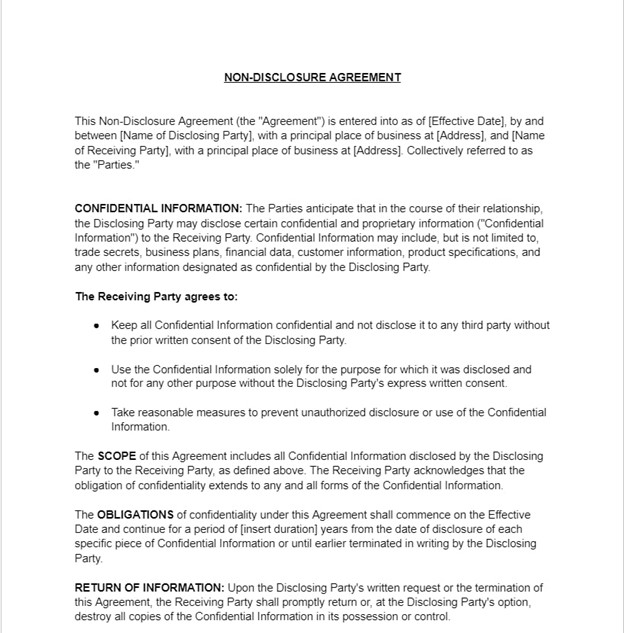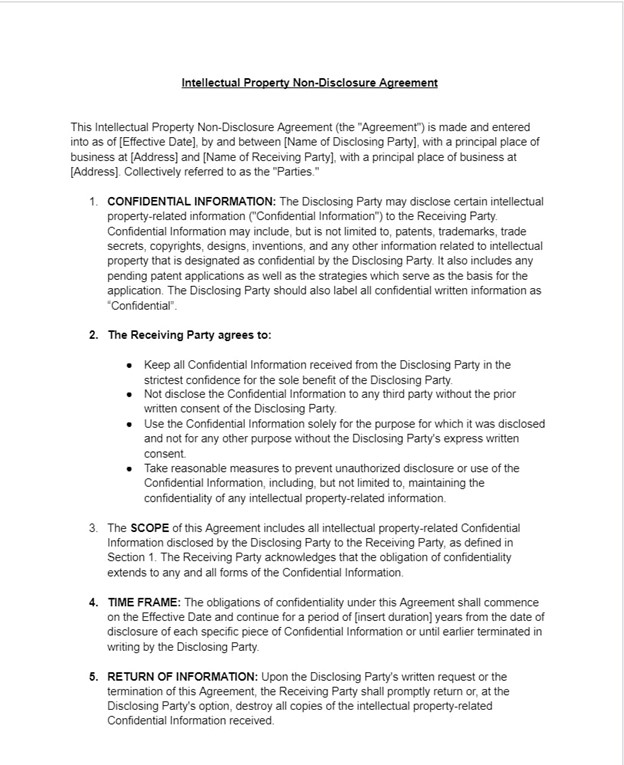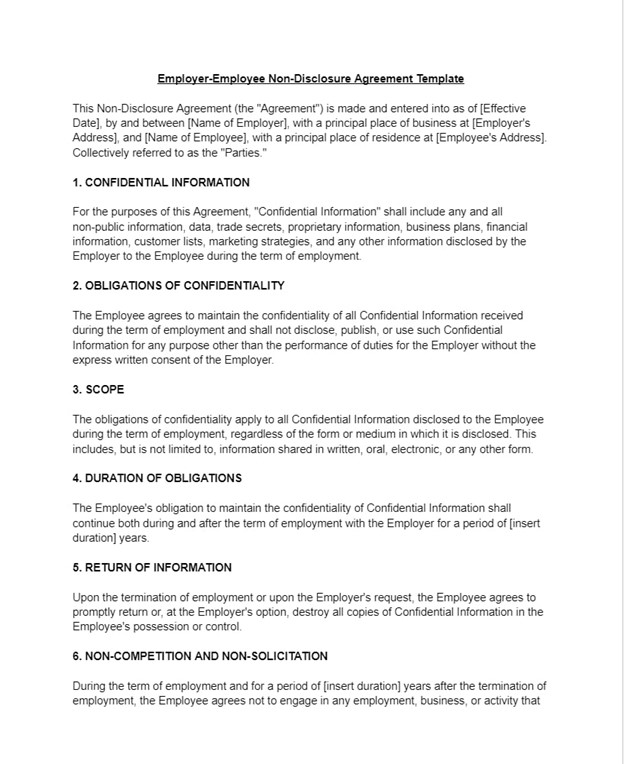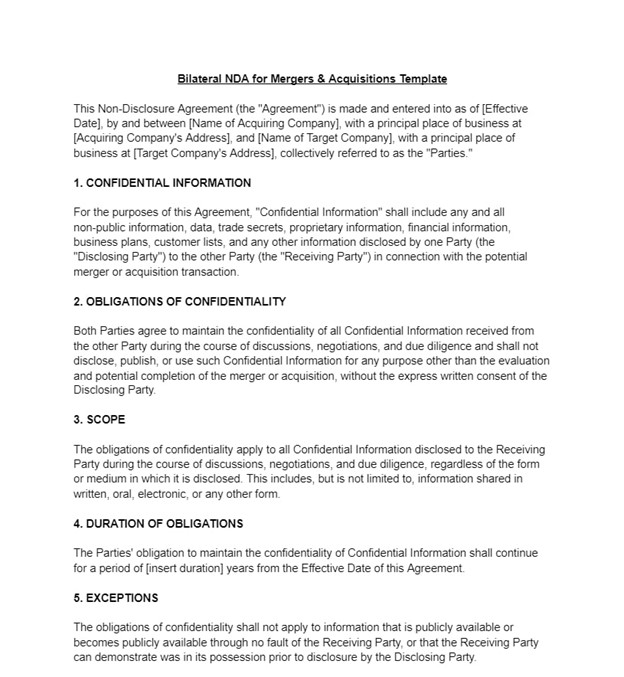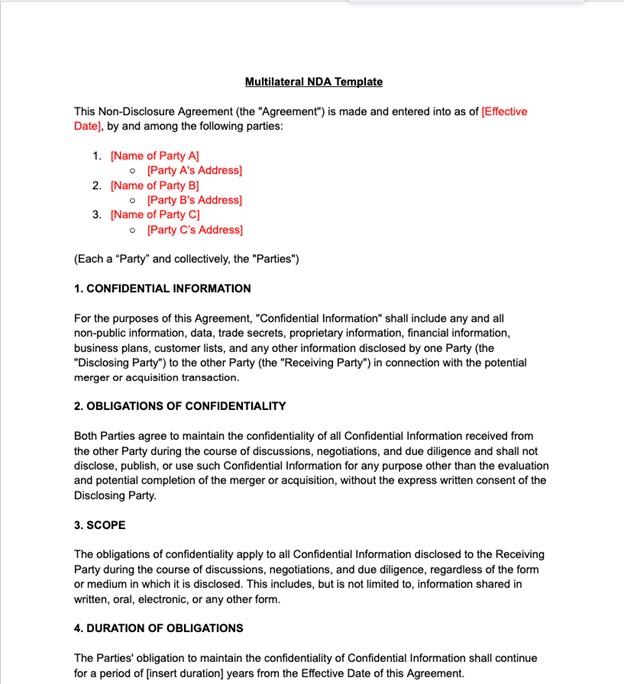A non-disclosure agreement (NDA), also called a confidentiality agreement, is a legally binding contract between multiple parties outlining the confidential information to be shared. It restricts the disclosure and use of that information by the receiving party. These agreements are used in different professional or business situations to protect sensitive information and maintain the confidentiality of valuable data.
Different Types of NDAs [+Templates]
There are three types of non-disclosure agreements: unilateral, bilateral, and multilateral. Read the subsections below for more information about each type and the scenarios/situations you can use them for. We also created a confidentiality and non-disclosure agreement template for each situation.
What to Include in an NDA
An NDA protects your business from a breach of contract, whether intentional or accidental by outlining the confidential nature of the information and imposing specific obligations to the receiving party. It ensures that any valuable information your business might have remains confidential and only those who are authorized can access it.
While NDAs might vary from one to another, here are the essential elements to include when drafting yours:
- Parties: You need to identify the parties that will enter into an agreement. It should include their names and addresses. This way, it is easier to identify who holds the responsibility when valuable information is disclosed while the agreement is still effective.
- Definition of Confidential Information: This section should lay down the types of information covered by the agreement. It specifically identifies what information is considered confidential.
- Obligations of the Receiving Party: This section outlines how the receiver should handle the information. It should also include the consequences if the receiving party mishandled the information.
- Scope: This section should ensure the enforceability of the non-disclosure agreement. Be specific about what type of information the NDA covers. Instead of just saying “valuable information,” use specific words, such as trade secrets, patents, business processes, financial data, etc.
- Duration: Some NDAs last for a specific period of time (i.e. five years, 10 years, etc.). In this section, indicate how long the receiving party should keep the information a secret.
- Return of Information: It specifies what the receiving party will do with the confidential information after the NDA expires.
- Exclusions: Not all information is confidential, and they should be specified in this section, such as information that is already public knowledge.
- Remedies: It outlines the courses of action to be taken if there is a breach of the NDA. This could include paying a certain amount of financial compensation to the disclosing party or injunctive relief.
Creating an Effective NDA—Best Practices
If you want to draft your own non-disclosure agreement template, here are some things to remember:
- Determine the type of NDA you need: Do you need a unilateral or bilateral agreement? Or perhaps you need a multilateral agreement? Just remember, if you are the only one disclosing confidential information, then you need a unilateral NDA. If both of you are exchanging sensitive information, you need a bilateral NDA.
- Don’t be too specific with confidential information: While you need to specify the type of confidential information, don’t be too specific to the point that you will reveal everything. For example, instead of saying the recipe of your restaurant’s signature dish, you can just say trade secrets or secret sauce.
- Ask for legal advice: NDAs could be complicated, especially if there’s a lot of exchange of confidential information. Having a lawyer review your NDA ensures that it is compliant with all the applicable laws.
Pros and Cons of an NDA
| PROS | CONS |
|---|---|
| Protects confidential information and safeguards it from unauthorized use | Enforcing an NDA can be quite challenging |
| Encourages communication and collaboration | Could convey a message of distrust |
| Serves as a legal framework for protecting confidential information | Drafting an NDA is complicated |
| Prevents people from misusing or exploiting your business’ confidential information | Legal costs for enforcing an NDA are expensive |
| Preserves your business’ competitive edge. | Some NDAs have overreaching terms that might unreasonably limit how the other party operates |
Consequences of Breaching an NDA
Breaking a non-disclosure agreement has serious legal consequences. The penalties they might incur could come from what’s stated in the NDA or any applicable law. Here are the most common:
- Legal Action: This is the most common consequence the affected party often takes against the other party. It generally leads to a lawsuit where the aggrieved party seeks damages, financial remuneration, or injunctive relief.
- Injunctive Relief: In this consequence, the court puts a restraining order on the breaching party to stop them from using the confidential information or from sharing it.
- Financial Remuneration: If the court proves that the NDA has been breached, the breaching party must pay the disclosing party for the damages incurred to them.
- Criminal Charges: If the breach involves activities such as theft or other unlawful activities, the guilty party might be subject to criminal charges.
Bottom Line
An NDA provides a layer of legal protection for you and your business. However, it could be too restrictive and damaging to the other party. Use the non-disclosure agreement templates we provided to get you started. However, don’t forget that it is essential to have a lawyer or an expert present when drafting an NDA. This ensures that it is fair to both parties and aligns with the specific circumstances and goals.
